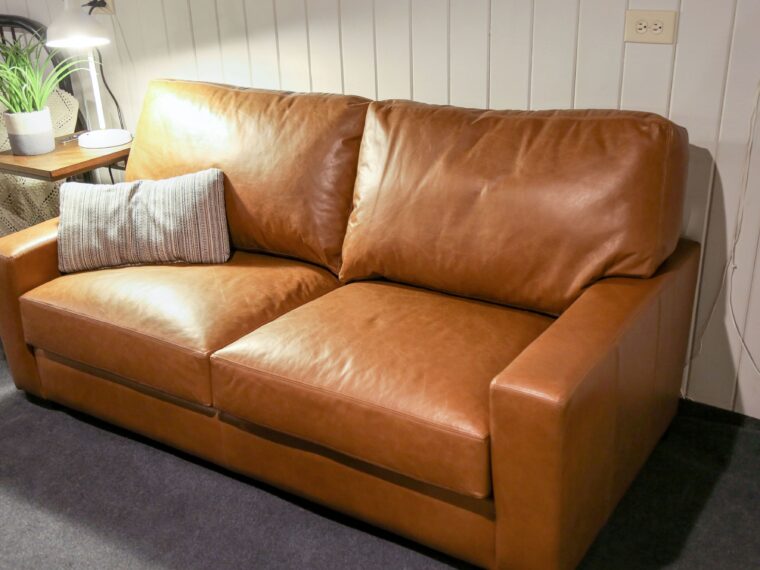What Should You Know Before Buying Cheap Leather Sofas?
Cheap leather sofas can deliver both quality and comfort when you understand what to look for. The key lies in recognizing that “affordable” doesn’t have to mean “disposable”—many budget-friendly options provide excellent value if you know how to evaluate them properly.
Your satisfaction with a leather sofa depends on several critical factors:
- Material type: This directly affects how the sofa feels, ages, and withstands daily use.
- Construction quality: This determines whether your investment lasts five years or twenty.
- Maintenance requirements: These influence the long-term cost of ownership beyond the initial price tag.
Understanding Materials
Two primary material categories dominate the affordable leather sofa market:
- Genuine leather crafted from real animal hide, offering natural breathability and a texture that develops character over time
- Air leather (synthetic alternatives) featuring engineered perforations for ventilation and a more uniform appearance
Each material brings distinct advantages in terms of durability, comfort, and price point:
- Genuine leather typically outlasts synthetic options by decades when properly maintained, developing a rich patina that many buyers find appealing.
- Air leather provides easier cleaning and lower upfront costs, making it attractive for budget-conscious shoppers or households with children and pets.

Importance of Construction
The construction beneath the upholstery matters just as much as the leather itself. Frame materials, stitching quality, and cushioning all contribute to whether your cheap leather sofa becomes a lasting furniture piece or a regrettable purchase.
What Types of Leather Are Best for Cheap Leather Sofas?
Genuine Leather
Genuine leather stands as the traditional choice among types of leather sofas, crafted from real animal hide—typically cowhide—that undergoes treatment to enhance durability. This material features a distinctive natural grain pattern, with each piece displaying unique characteristics that make no two sofas identical. The texture develops a rich patina over years of use, softening gradually while maintaining structural integrity. Genuine leather adapts to body temperature, creating a living material that responds to its environment.
Air Leather
Air leather represents a modern synthetic alternative designed to replicate the leather experience at a fraction of the cost. This breathable material incorporates microscopic perforations throughout its surface, allowing air circulation while maintaining a leather-like appearance. Manufacturers create air leather with a uniform texture and consistent color, eliminating the natural variations found in genuine hides. The material’s top layer features a protective coating that repels moisture and simplifies cleaning routines.
Key Differences Between Genuine Leather and Air Leather
The appearance differences between these materials become apparent upon close inspection:
- Genuine leather showcases organic imperfections and grain variations
- Air leather presents a more polished, consistent surface
When it comes to touch:
- Genuine leather feels supple and warm
- Air leather has a cooler, slightly plastic feel
Price Comparison
Price gaps reflect these quality differences—genuine leather sofas typically cost 40-60% more than their air leather counterparts, though both options remain accessible within budget-conscious price ranges.
How Does Comfort Vary Between Genuine Leather and Air Leather Sofas?
Sofa comfort depends heavily on how each material responds to body temperature and environmental changes. Genuine leather excels at leather sofa temperature regulation, adapting to your body heat by staying cool during summer months and warming up in winter. This natural characteristic comes from the hide’s porous structure, which allows air circulation while maintaining contact with your skin.
Breathable leather performs differently depending on its type. Genuine leather’s organic fibers create microscopic channels that wick away moisture and prevent the sticky, uncomfortable feeling common with non-breathable surfaces. Air leather incorporates deliberate perforations to enhance airflow, offering better breathability than solid synthetic materials but falling short of genuine leather’s natural ventilation system.
The sitting experience shifts noticeably between materials across seasons:
- Summer use: Genuine leather remains cooler to the touch and prevents sweat accumulation, while air leather’s perforations provide adequate ventilation though some heat retention may occur
- Winter comfort: Genuine leather warms quickly from body heat, creating a cozy surface, whereas air leather stays cooler longer and may feel less inviting in cold rooms
- Extended sitting: Genuine leather molds to your body shape and maintains comfort during long periods, while air leather’s uniform surface may feel less adaptive
Your material choice directly affects daily comfort patterns, particularly if you spend considerable time on your sofa or live in regions with temperature extremes.
What Are the Durability and Maintenance Considerations for Cheap Leather Sofas?
Genuine leather sofas can last 15-25 years with proper care, while air leather typically provides 5-10 years of service. The significant difference in sofa durability stems from the inherent properties of each material—genuine leather develops a rich patina and becomes more supple over time, whereas synthetic alternatives may crack or peel as they age.
Maintenance requirements
Maintenance requirements differ substantially between these materials:
- Genuine leather needs regular conditioning every 6-12 months to prevent drying and cracking
- Immediate attention to spills prevents permanent staining on natural hide
- Periodic dusting and gentle cleaning with specialized leather products maintains appearance
- Protection from direct sunlight and heat sources prevents fading and damage
Air leather demands less intensive care due to its protective coating:
- Simple wipe-downs with damp cloths handle most spills effectively
- The waterproof surface resists stains without special treatments
- No conditioning products required for maintenance
- More forgiving with everyday wear and accidental spills
Leather maintenance tips
Leather maintenance tips for extending lifespan include vacuuming crevices weekly to remove debris that causes premature wear. For cleaning leather sofas, test any product on hidden areas first. Genuine leather benefits from professional cleaning every few years, while air leather maintains its appearance with basic household cleaning methods. Understanding these differences helps buyers choose materials matching their lifestyle and maintenance capabilities when selecting quality cheap leather sofas that last.
How Does Cost Influence the Choice Between Genuine Leather and Air Leather Sofas?
Does the price difference between genuine and synthetic leather justify the investment? Air leather sofas typically cost 40-60% less than genuine leather alternatives, making them attractive for tight budgets. A quality air leather sofa might range from $400-$800, while comparable genuine leather pieces start at $1,000 and easily exceed $2,000.
What does the cost-to-quality ratio reveal about affordable leather sofas? The initial savings with air leather come with trade-offs in longevity. A genuine leather sofa lasting 15-25 years costs roughly $80-$130 annually when spread over its lifespan. Air leather sofas surviving 5-10 years average $80-$160 annually—similar or higher per-year costs despite lower upfront prices.
When does spending more upfront create better value? Buyers planning to keep furniture for a decade or more benefit financially from genuine leather’s durability. The material develops a rich patina and maintains structural integrity, eliminating replacement costs. Air leather serves well for those expecting lifestyle changes, frequent moves, or needing temporary solutions.
Which budget-friendly options maintain acceptable quality standards? Look for bonded leather or split leather as middle-ground alternatives. These use genuine leather components combined with synthetic materials, offering better durability than pure air leather at prices closer to synthetic options. Cost comparison genuine vs synthetic becomes less stark with these hybrid materials, delivering reasonable longevity without premium pricing.
What Ethical Factors Should Buyers Consider When Choosing Leather Sofas?
Ethical furniture buying requires examining both environmental and animal welfare impacts. Genuine leather production involves significant resource consumption, including water usage, chemical treatments for tanning, and greenhouse gas emissions from livestock farming. The tanning process often uses chromium and other chemicals that can pollute waterways if not properly managed.
Animal-friendly furniture options like air leather provide alternatives for buyers uncomfortable with animal-derived materials. These synthetic options eliminate concerns about animal welfare while offering similar aesthetics to genuine leather. Air leather production typically has a smaller carbon footprint and avoids the ethical complexities of animal agriculture.
The choice between materials creates tension between ethical priorities and practical needs. Genuine leather’s exceptional durability means fewer replacements over decades, potentially offsetting its higher environmental cost per unit. A single genuine leather sofa lasting 20-30 years may have less cumulative impact than replacing synthetic alternatives multiple times.
Sustainable sofas require weighing immediate ethical concerns against long-term environmental effects:
- Genuine leather offers longevity but higher initial environmental cost
- Air leather provides animal-free options with moderate durability
- Production methods vary significantly between manufacturers
- Disposal considerations differ between biodegradable leather and synthetic materials
Buyers must prioritize their values—whether animal welfare, environmental impact, or resource efficiency matters most—while considering how durability affects overall sustainability.
What Construction Features Indicate Quality in Cheap Leather Sofas?
1. Frame Quality
Sofa frame quality determines whether your furniture will last years or collapse within months. Hardwood frames crafted from kiln-dried oak, maple, or beech provide exceptional strength and resist warping. Metal frames offer similar durability at competitive prices, though they may lack the traditional feel of wood construction.
2. Stitching Quality
Sofa stitching quality reveals manufacturing standards at a glance. Double-stitched seams withstand daily use far better than single stitching, particularly along armrests and seat edges where stress concentrates. Examine seam lines for consistent spacing and tight thread tension—loose or irregular stitching signals rushed production that won’t survive regular wear.
3. Cushioning Materials
Cushioning materials directly impact both comfort and posture support. High-density foam (minimum 1.8 pounds per cubic foot) maintains shape through years of use, while lower-density options flatten quickly. Look for cushions combining foam cores with fiber wrapping, which creates a softer surface without sacrificing structural support. Spring systems beneath cushions add bounce and distribute weight evenly across the seat.
4. Leather Finish
The leather finish acts as your sofa’s first line of defense against daily damage. Protected or pigmented finishes create a barrier that resists scratches, spills, and UV fading. Test the surface by pressing firmly with your thumb—quality finishes won’t show immediate marks or color changes. Glossy top coats on air leather provide waterproof protection that simplifies maintenance.

How Can Buyers Balance Quality, Comfort, and Affordability When Selecting a Leather Sofa?
Choosing affordable quality sofas starts with identifying your personal priorities. Air leather works well for households with children or pets where easy cleaning matters most, while genuine leather suits buyers seeking lasting leather furniture that develops character over time.
The smartest approach to comfortable cheap sofas combines material selection with construction evaluation. Check the frame material even on budget options—hardwood or metal frames paired with air leather often provide better value than genuine leather on particle board frames. Test the cushion firmness in person to ensure proper support for your body type.
Practical shopping strategies maximize your investment:
- Visit showrooms during sales periods when quality pieces receive significant discounts
- Request material samples to compare texture and breathability at home
- Examine warranty coverage as an indicator of manufacturer confidence
- Measure your space carefully to avoid costly returns
- Read customer reviews focusing on long-term durability feedback
- Consider floor models or previous season designs for substantial savings
How to Choose Quality and Comfort with Cheap Leather Sofas That Last requires balancing immediate budget constraints against long-term satisfaction. A moderately priced genuine leather sofa with solid construction typically outlasts multiple cheap replacements. Calculate cost-per-year rather than upfront price to identify true value in your furniture investment.
Related : The Best Spots to Buy Chaise Sofas Sydney Homeowners Recommend


